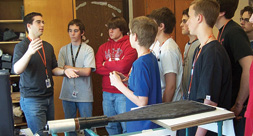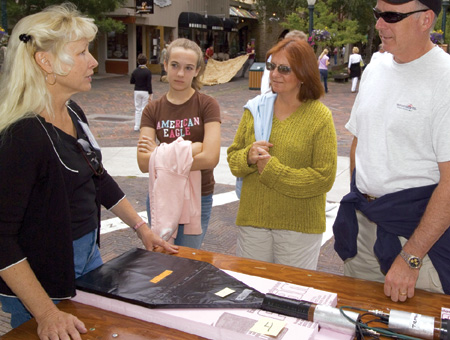Tom Jordan: Tools for schools
The QuarkNet e-Lab provides teachers and students access to some of the tools that scientists use. The Web-based electronic laboratory helps students and teachers to investigate scientific questions from simple to complex.
Teaching and learning physics in the 21st century
It began with an intense argument. Proponents of one or another viewpoint insisted on evidence and reason. Each side felt that their arguments were sufficient to carry the day. Small groups conferred to reinforce their points of view. But consensus slowly began to emerge as the groups worked throughout the day.
This could describe a gathering of particle physicists collaborating on an experiment or debating the design of the new International Linear Collider. It wasn't. The participants were teachers at a workshop organized by physicists from Johns Hopkins University. They were exploring data from several cosmic-ray detectors and working to discover the answer to their significant question: "Does the arrival rate of cosmic rays change over a 24-hour day?"
The teachers are part of QuarkNet and were learning about a Web-based electronic laboratory (e-Lab) that uses grid-computing techniques and resources to allow uploading and sharing of data, compiling and executing analysis routines, as well as saving and publishing results. In the classroom, students and teachers from US high schools use the site to investigate scientific questions from simple to complex.
The e-Lab users employ a series of Web forms to select and send their data for analysis. The e-Lab computers push the results back to the user's Web browser. Users can tweak the analysis by modifying parameters, or show the results to another user for comment. They can even publish an online poster describing their findings. Other users can leave comments on the posters and results.
The e-Lab features a logbook in which users can paste interesting plots or leave notes for later reference. Teachers can look at the logbook entries their students make and leave comments or questions for later consideration. The e-Lab enfolds teaching and learning with the Virtual Data System of the Grid Physics Network (GriPhyn) so that computing jobs or data storage can be supported by the growing resources of the Open Science Grid. For example, data from the cosmic-ray project, like those of most modern physics experiments, require far more computing power and storage capacity than available on classroom computers. The Open Science Grid allows schools to access the resources necessary to do such projects.
QuarkNet has worked with hundreds of physics teachers and physicists since 1999. The program receives funding from the DOE Office of Science and the National Science Foundation. It helps teachers to improve their understanding of science content as well as tools and processes of science.
Five hundred and sixty teachers participate in the program at 53 US institutions. Particle physicists at local universities serve as coaches and mentors. They interact with the teachers in workshops, at their lab benches, and over coffee to talk about new discoveries and ways to help students learn. Both groups of professionals are invested in science; each side can help the other to explore new territory.
| High school senior Marshall Burhoff (left) explains his work with the QuarkNet cosmic-ray detector and the e-Lab to a group of underclassmen. Photo: Tom Jordan, Fermilab |
 |
| Cheryl Brooks (left) is a teacher in the QuarkNet program. At a recent outreach event, she explained the unique role that cosmic-ray detectors (bottom) can play in classroom science education. Photo: Reidar Hahn, Fermilab |
|
 |
|
Short of having particle accelerators and colliding detectors in each high school, students have little opportunity to collect any evidence that particle physics is as real as the falling apple that demonstrates Newton's second law of mechanics. QuarkNet enabled many teachers to build cosmic-ray detectors for their classrooms. Scintillating plastic, photomultiplier tubes, readout electronics, and a cheap PC comprise the recipe for a tool that students and teachers can use to explore particle physics in their schools.
Students use these detectors to study cosmic-ray flux, measure muon lifetimes, and search for events simultaneously recorded at several nearby detectors—an indication of extensive showers from highly-energetic cosmic rays. The students must assemble, calibrate, commission, repair, and re-repair their detectors. They must pull cable to the roof so that they can detect GPS satellites for precise timing. They must record which channel on the readout indicates which counter. They must be skeptical about what they observe and explore simple explanations before pronouncing the observation of a new phenomenon. If they believe the observation, they must repeat it—or at least be sure that it was not happenstance.
Sounds familiar? It does to an experimentalist! These intrepid students and teachers are performing the very same tasks as those lucky few who get to crawl over, around, and through the massive particle detectors that allow us to peek at the universe in much more interesting conditions than one can find in the local coffee shop. While cosmic-ray events may not contain the same information that Large Hadron Collider events will, they represent an opportunity for students to collect and analyze data in much the same way as modern particle physics collaborations.
These classroom detectors coupled with the grid-enabled e-Lab environment allow students to create engaging experiments, to ask tough questions, and to come closer to doing real science than in most other opportunities for high school students.
Teachers of science—and their students—must understand the true nature of scientific work. They must appreciate that there are few scientists with scientific method posters hanging in their office. (I only know of one, in Fermilab's Wilson Hall.) Students must realize that science is a field of starts and stops, intensive collaborations, mind-numbing repetition, breathtaking inspiration, and, yes, even politics. Most importantly, students must become adults who can parse a headline like "315 Physicists Report Failure in Search for Supersymmetry" (New York Times, January 5, 1993) and get the true story. QuarkNet's network of professionals and our exploration of e-Labs will support this understanding, appreciation, and realization.
Tom Jordan
For more information about e-Labs, see http://quarknet.fnal.gov/e-labs/
Tom Jordan is a member of the Fermilab Education Office. He is one of five educators who monitor and nurture the QuarkNet program, organize workshops, and visit QuarkNet teachers at their high schools, even sitting in on classroom sessions. He has contributed to the development of the cosmic-ray e-Lab.
Click here to download the pdf version of this article.


